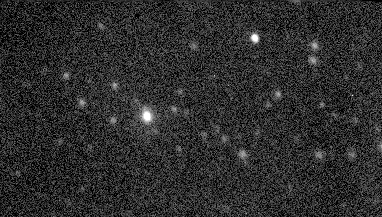

The giant cD galaxy IRAS 09104+4109 is the bright central object in
this cluster of galaxies at z=0.442. This is among the most distant
(and thus most intrinsically luminous) objects detected from the
IRAS Point-Source Catalog. Detailed study at a variety of wavelengths
has been carried out, first from KPNO, Mauna Kea, the VLA, and La Palma,
and most recently with the Keck and Hubble telescopes (at which
point I got off). The enormous IR luminosity is powered by
a hidden active nucleus of quasar luminosity, about 99% of whose
energy is absorbed by surrounding dust. Emisison-line and polarization
measurements show that the escaping 1% ionized surrounding gas,
so that we do see weak signatures of the active nucleus in visible and
near-UV light. The spectrum below (from the 2.5m Isaac Newton telescope
on La Palma) shows the typical high-ionization features such as
[O III] that betray an AGN as the power source for the ionized gas./p>

This galaxy is somewhat unusual among strong far-infrared sources in occurring in the central galaxy of a rich cluster. The surrounding galaxy has all the earmarks of a cD galaxy, and the cluster is noteworthy for its apparent flattening.
This is from the original (1985) optical identification image, taken in red light at the 2.1-meter telescope of Kitt Peak National Observatory. The field is 160" along the long side. The image depth and flatness are not all I could have wished, since the moon was two days from full, but it served its purpose.
 UA Astronomy Home Page
keel@bildad.astr.ua.edu
UA Astronomy Home Page
keel@bildad.astr.ua.edu Last changes: November 1997